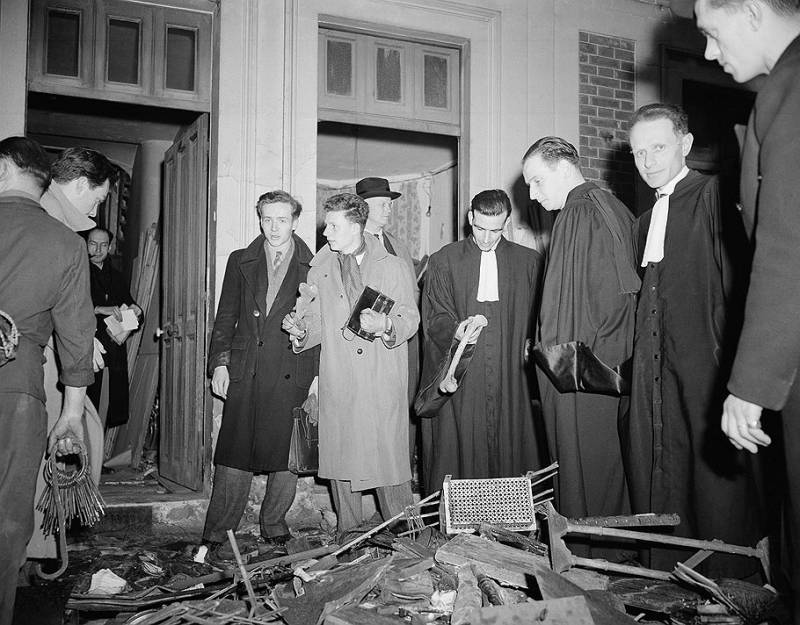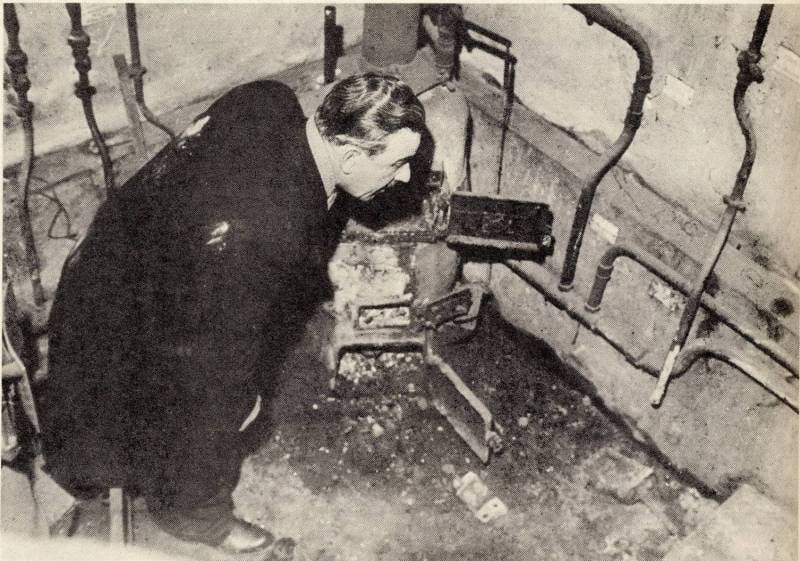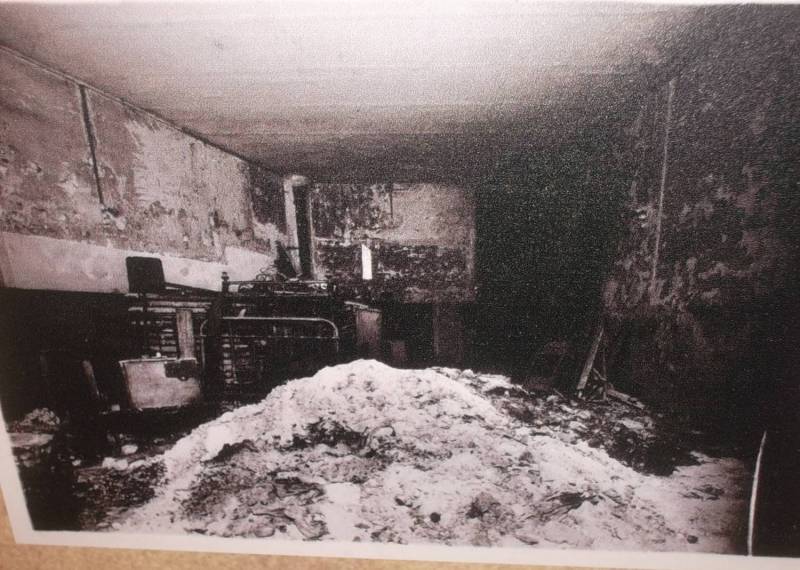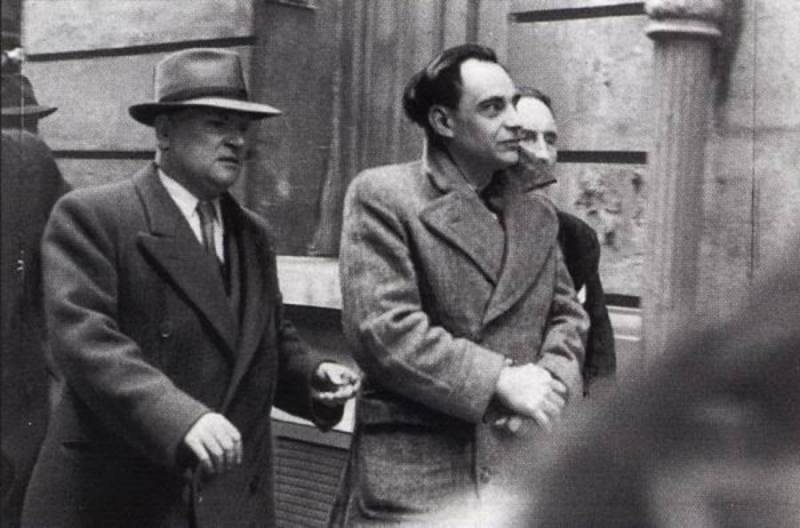Satan existed. And he lived in Paris
Fighter against invaders
On the eleventh of March, 1944, the morning of the policemen of the sixteenth arrondissement of Paris began routinely and habitually. However, soon the notorious "Groundhog Day" was canceled. Locals turned to them with a complaint, saying that from the chimney of the house at number twenty-one that day already terribly unpleasant, causing nausea smoke. Since this mansion and nearby buildings were located in the city center, their tenants were wealthy and influential people. Therefore, the police had on the same day to go to the house twenty-one to find out the reason for the disgusting smell.
Upon arrival, the police were convinced that the rich inhabitants of the sixteenth district are not deceiving or capricious. From the chimney of the mansion really poured smoke, from which it was far from being "alpine freshness." The house itself was closed. The corporal found out that it belongs to a respected person - Dr. Marcel Petio. The policeman was able to contact him by phone and asked to come. But an hour later, Petio did not appear. Therefore, the corporal ordered his subordinates to knock out the door. Once inside the guards realized that the source of the nasty smell is down in the basement. They descended the stairs. In the basement there was a huge stove in which flames raged. A charred human hand was sticking out of the firebox ... Next to the furnace, the police saw a large pile of coal mixed with bones. We must pay tribute to the corporal and his subordinates, they stoically stood the test of the hellish picture. Soon a brigade of criminal police arrived to help them. Now the house of twenty-one came under their jurisdiction. And after the criminalists came the owner of the terrible mansion.
In fact, the evidence found in the basement was enough to immediately arrest Petio, but ... The yard was 1944 year, France was in an occupied state. This is what the doctor played. He stated to the police (by the way, the French) that he was part of the Resistance, and the remains belong to the Germans and collaborators. Like, in this way, he fights against the hated invaders. And if they arrest him now, they will commit a crime against the homeland, because he killed in the name of a proud and bright sense of duty to his country. Corporal, police and criminologists were impressed by such sentimental and patriotic speech. Therefore, Petio was advised to be more secretive, after which they left the mansion. And Marcel, without thinking twice, immediately went on the run. He understood that soon the Germans would come instead of the French and then he would not be able to get out.
Special "label"
But the case "Mansion on Lezer, twenty-one," one way or another, was not closed. Although slow, the investigation continued. During the search, the remains of at least sixty people were found in the basement. Most likely, there were more of them, but since many bones were severely crushed, the exact number of victims could not be determined. But it turned out to find out the identity of more than twenty-seven dead - their documents were found in the house. It was then that Petio was deceived. The victims were not occupiers, and the French and Jews. And the remains belonged to men, women and children. The case of two years ago arose, when for several months the police had to catch human remains from the Seine. Then the exact number of victims also failed to establish, according to approximate estimates, thirteen people. In addition, between December 1941 and May 1943, police found human remains in various parts of Paris where experts found traces of drugs and curare's poison. Rumors spread around Paris that a serial killer was running in the city. However, since May 1943, the dreaded discoveries no longer appeared. Then the guards of the order concluded that the maniac either committed suicide or some accident happened to him. The case is safely closed. And after a search in the house of Petio, everything fell into place. The serial killer did not die, he just found a new, safer way to get rid of the corpses.
The police are lucky. An expert continued to work in her ranks, and she already had to deal with Petiot's “creativity”. Even then, several years ago, he drew on the "label" with which the criminal, as if he put his "authorship". He always thrust a scalpel into the thigh of the victim. Exactly the same injuries were found on human remains in the mansion of Marseille. It became clear that the serial killer and the doctor are one and the same person.
On the twenty-fourth of August 1944, a landmark event occurred - Paris was liberated. And most of the policemen were arrested as accomplices of the occupation regime. It seemed that the Petio case was now definitely lost in the chaos that had been created. But Marcel unexpectedly reminded himself. He began to bombard the Paris newspapers with numerous letters in which he claimed that the Germans had framed him, and he himself was a true patriot, one of the members of the Resistance movement. According to Marcel, the invaders tried to reach other fighters for independence through him, and the corpses of the French and Jews in the basement - their revenge for the failure to cooperate. This was done in order to denigrate it and compromise. These numerous messages have attracted the attention of new criminal police officers. And the case was resumed. Soon the law enforcement officers managed to detain the brother of Marseille - Maurice Petio. In the chamber he was treated, to put it mildly, inhumanly. Maurice was subjected to exhausting interrogations that lasted for several days without a break. And, in the end, he could not resist. Maurice said that at the request of his brother, he took out all the personal belongings that were in special hiding places. Then he hid them with his friends and acquaintances. The police, of course, visited the "guardians." Maurice did not lie, they had clothes and shoes, and of different sizes.
Soon, another Petiot case surfaced. This time, the archives of the Paris Gestapo played their part. They said that in April 1943, Ivan Dreyfus was arrested. As a result of interrogation with passion, he agreed to cooperate with the Germans. He was required to withdraw the invaders to the Parisian underground fighters who secretly smuggled the Jews to South America. Some time later, Dreyfus announced that an organization was operating in Paris that helped them get out of the country. He also named the names of three people: Pintar, Furrier and Nizonde. And the organization was headed by a certain Dr. Eugene. The agent himself after this information disappeared. But the Gestapo managed to arrest three Frenchmen. Under torture, they said that Dr. Eugène is Marcel Petio. They did not possess any more information. The Gestapo established surveillance of Petio, but did not have time to arrest him - the Resistance sharply intensified. The Germans were not corny to the French benefactor. Therefore, soon the case Petio sent to the archive.
French police began searching for a doctor. On October 30, 1944, at the station of Saint-Mandé, the guards carried out a routine check of documents. They were stopped by a man who was visibly nervous. He showed a certificate in the name of Henri Valerie Watterwald, a captain and counterintelligence officer of the French internal forces, as well as a former member of the Resistance. But gendarmes thought that Henri looked like Petiot. A suspicious man was detained and began to investigate. During the search, he was found several more different identity cards. Watervalda arrested. And after the confrontation with his wife and brother, the police were convinced that Marcel Petio was in their hands. It soon became clear that the numerous things found in the apartments of the friends of the doctor belonged to Jewish refugees. The investigation began to unravel the case of Petio with a vengeance.
History of the doctor
The police found out that Marcel Petio was born on the seventeenth of January, 1897, in Auxerre. But about his childhood, nothing concrete could be unearthed by the guards. The only thing they learned - in his childhood Marcel was subjected to violence, in connection with which he received a severe psychological trauma. However, it was later questioned. Therefore, the true reasons for which Petio began to commit murder, and did not know. But it appeared that Marcel was expelled several times from school for bad behavior, and in March 1914 of the year the medical commission recognized him as mentally ill. Therefore, Petio had to finish his studies in a special academy.
However, in January 1916, Marcel was drafted into the army, closing his eyes to the medical opinion. Nineteen year old guy hit the infantry. In Ene, he was seriously injured, as well as gas poisoning. And soon he was demobilized, once again, recognizing the mentally ill. Petio's treatment took place in rest homes, but the rehabilitation course did not fully pass. He was arrested for theft and sent to Orleans prison. But here the guy did not last long. From prison, he was transferred to Fleury-les-Aubre hospital. And from there in June 1918, Petio returned to the front. But after a couple of weeks, he went to the hospital for injuries. It turned out that he himself shot in the leg.
When the First World War died down, Marseille received a medical education in an accelerated training program for veterans. And after - became an intern in a psychiatric hospital Evre. At the end of 1921, he received his doctorate and moved to Villeneuve-sur-Ion. Here he quickly managed to win the confidence of not only patients, but also the local government. Taking advantage of his position, Petio began to test various narcotic substances prohibited in France. He also illegally aborted.
Apparently, just at that time, Petio and committed his first murder. The police speculated that his victim could well be Louise Delavo, who disappeared in May 1926. According to unconfirmed data, Marcel and Louise were lovers. Then there was a conflict between them. The only clue of the law enforcement officers was the testimony of neighbors who saw Marcel loading a heavy box into the car. Of course, the doctor became the main suspect, but could not prove his guilt. According to the official version, Delavo just ran away, deciding to start life from scratch. However, after some time, the police caught in the river a similar box in which they found a dismembered body. The examination established that the remains belonged to a young woman, but her identity remained unknown. The case was closed.
Another interesting thing: in 1926, Petio won the mayoral election in Villeneuve-sur-Ion. After gaining power, he began to steal funds from the city treasury. And he did it openly, without fear of justice. In 1927, Marcel got married. Soon he had a son.
But the population of the town did not give Petio a calm life. People with enviable constancy complained to the prefect about the financial frauds of their mayor. Therefore, four years later, Marcel had to resign. At the same time, he somehow managed to hush up the matter and avoid punishment. Moreover, a month later he managed to get into the Council of the District of Yonne. But six months later, complaints and accusations fell on him again. Petio resigned and moved to the capital. On this his political career ended.
In Paris, Petio's career went up. He quickly earned himself a reputation as a good doctor, although he continued to actively use "unconventional" medicine. However, gradually, rumors spread around the city that Marcel was doing illegal abortions, and also prescribed drugs to his patients that were addictive. That's just on his activities that did not cast a shadow. Rather, on the contrary, in 1936, the doctor achieved his cherished goal - now he could legally compile death certificates.
When World War II began and the Germans occupied France, Petio quickly found his place. He began selling health certificates that allowed him to avoid being sent to work in Germany. In the 1942 year, when the occupation regime tightened, Marcel found a gold mine. A lot of people at that time wanted to leave France. But it was not legal to do that. There was only one risky way - illegal. And the doctor began offering his services. He was wielding not one - the company was made up of several accomplices. They were precisely Furrier, Pintar and Nizonde, later seized by the Gestapo. True, they did not know anything about the true intentions of Petio. Their task was only to search for people able to pay a large sum for the escape. Moreover, their nationality, occupation and past did not play a role.
Marseille for their services requested twenty-five thousand francs. For those times - this is a fantastic amount. But there were many who wanted to escape. After all, Dr. Eugene promised that for this money he would be able to organize an escape to Argentina or any other country in South America through his “channels” in Portugal. People came to the mansion, where Dr. Eugene did vaccinations for people, explaining that the requirements of the authorities of overseas countries. That's just instead of the vaccine, he injected them with poison.
At first, the doctor simply dumped the corpses into the Seine. Then the dismembered remains (Petio made every effort so that the corpses could not be identified) he literally scattered around Paris. But in 1943, Marcel decided that this method was no longer suitable, so he hid them in the basement. And in 1944 I began to systematically chop and burn bodies in the basement of my own mansion.
***
A jury convicted Marcel Petiot of the murder of twenty-six people and sentenced him to death. It happened on the twenty-eighth of March 1946. How many people sent Doctor Satan to the next world - it was not possible to establish for certain. The police officers who conducted the case were confident that he had at least six dozen victims. On May 25, 1946, Marcel Petio was sent to the guillotine.
In 1990, Christian Shalonj shot the film "Dr. Petiot", in which the role of Marcel was played by Michel Cerro.
In the Belgian film “New Testament” there is a phrase: “God exists. And he lives in Brussels. ” The French may well respond to this: “Satan existed. And he lived in Paris. "




Information